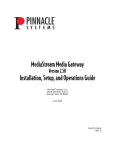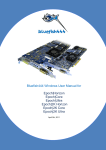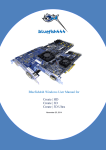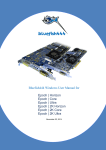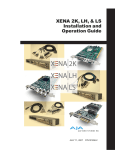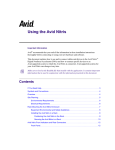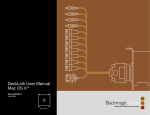Download Pinnacle Avid Liquid 7.0
Transcript
Avid Liquid v7.0 Recommendations for System Builders Systems & Workstations Generic Cookbook December 2005 Avid Technology, Inc. Avid Technology Park, One Park West, Tewksbury, MA 01876 Copyright © 2005 Avid Technology, Inc. All Rights Reserved. Product specifications are subject to change without notice or obligation. Avid Liquid – Recommendations for System Builders OVERVIEW: Technical Background Explains how Liquid processes data and explains how PC components impact Liquid’s performance. Build Your Own System Explains how to build a cost-effective non- xw8200 system that meets the customer’s expectations. TECHNICAL BACKGROUND During capture, the incoming video and audio signal is converted to an uncompressed data stream in the Liquid Pro box and sent to the PC via the USB 2.0 interface. It is essential that the USB port is operating correctly and delivers full USB 2.0 performance. For DV and HDV, the signal arrives to the Liquid Pro box encoded and is transferred to the system via the USB 2.0 connection. Within the PC, the data is delivered to the main memory via the PCI bus, then sent from there to the VGA card, which displays the video inlay in the Logging Tool, and simultaneously to the CPU. The processor encodes the stream with the selected codec. The CPU usage for MPEG-2 encoding is much higher than for DV, thus only a fast processor is capable of doing real time MPEG-2 encoding. Finally, the encoded data is transferred to the hard disk via the main memory (see illustratio n) and written in the selected format (DV AVI, DV DIF, MPEG-2). The reverse process applies for playback and editing. At first, the data is read from the hard disk to the main memory. The CPU takes the data from the main memory and decodes to YUV (uncompressed) for further processing. The decoded video is written back to the main memory. Now CPU and GPU effects can be rendered on the original video. CPU and GPU effects read the uncompressed data of the frames they have to process from RAM and calculate new frames based on effects and filters. The rendered frames are then read back by the graphics card for inlay display. They are also sent to the main memory and from there to the Pro box (via USB 2.0). The Pro box delivers the uncompressed signal to the analog outputs. The importance of CPU and GPU performance is obvious. Encoding / decoding and effects processing will be sped up with a faster CPU and GPU. More video RAM on the graphics card also helps to improve performance and allows a higher number of streams being processed simultaneously. The frame size of HDV benefits from both more video RAM as well as a faster graphics bus. PCIe is best. BUILD YOUR OWN SYSTEM If you prefer configuring a system based on your favourite turnkey PC or motherboard, please take a look at the following general recommendations: Storage • S-ATA drives are generally acceptable for system data and video material • Recommended: separate system drive and at least one drive for audio / video storage • Stripe set for video data recommended (two or more identical drives) System Disk • SATA: J low price, high capacity K performance L reliability • SCSI: J highly reliable J good performance L high price, lower capacity • SCSI disk with SATA interface J lower price K lower performance, capacity and reliability Conclusion: use what you prefer, if you want to use a SCSI JBOD on the onboard dual channel SCSI controller you should choose the SATA or SCSI on SATA interface for the system drive to keep both SCSI channels reserved for the JBOD. Video Data Storage • SATA or SCSI single disk: sufficient for lower data rate media like DV or HDV, and if the disk space is not critical. • SATA RAID (with onboard RAID controller): cost efficient solution with high security (due to higher RAID levels), flexible disk space, slightly lower performance than SCSI JBOD • SCSI JBOD, single or dual channel: this would be the choice for high reliability, flexible disk space and high performance. Choose SCSI dual channel for all HD uncompressed work. A more expensive solution. • SCSI RAID level 5: Usually the best performance and reliability, but the highest price. Conclusion: use whatever meets your needs best! The Chipset And The CPU(s) • We recommend using Intel chipsets and CPUs, but there is no technical objection to building systems based on AMD chipsets and CPUs. • Dual core CPUs will also improve performance for CPU intensive operations in Liquid. • Single or dual CPU with at least 3.0 GHz (dual CPU preferable; enable HyperThreading!) • Check motherboard technical specifications for onboard USB 2.0 controller and compare with our compatibility list (click here) The CPUs have a high impact on the general system performance: a. Process the software functions itself b. Encode the uncompressed data stream of the Liquid Pro box (see above) c. Handle the decoding of the compressed media (like DV, HDV) d. Process the realtime CPU effects, which are the higher quality realtime effects e. Process all media data, like all of the data needed for an HD image; bear in mind that the CPUs decompress the data, so a HDV clip with a data rate of 25 MBit on the disk becomes huge after decompression and processed in the system. Conclusion: The higher the CPU frequency (> 3 Ghz) and the more CPUs (hyperthreaded or second physical CPU), the better for the general system performance, for the realtime effects playback and for other functions like export. If working with HD/HDV, aim to meet or exceed the recommended system requirements. Finally, output via breakout boxes does tax CPU performance. The RAM • Install at least 1024 MB RAM (more RAM will further improve system stability and performance!); this is indeed strongly recommended, otherwise overall performance will decrease remarkably! We encourage you to use 2GB RAM with Liquid. • The Windows XP operating system itself allocates a relevant part of the installed physical RAM. Therefore, 2 GB RAM are minimum for chrome HD, otherwise the system will not work properly. • Even more RAM (beyond 2 GB) will not increase performance significantly Conclusion: 2 GB RAM is ideal. Graphics Card / Graphics Interface • PCIe graphics interface is preferable over AGP 8x; if you do not intend to work with HD or HDV 1080, you may use also an AGP 8x system • Do not use motherboards or systems with onboard graphics chips! • Currently ATI graphics cards are preferable over NVIDIA cards (because of better read-back performance) • 256 MB of video RAM highly recommended • Your graphics card MUST support DirectX 9 in hardware. (You will also need to check that you have the latest DirectX 9 software under Windows). Background information: The graphics card is highly integrated into Liquid’s internal data processing. A state-of-the-art GPU (Graphics Processing Unit, processor on the graphics card) is very powerful and processes the video that has been decompressed by the CPU. The graphics board has a significant influence on the performance if you are using realtime GPU effects, as the load for decompression and realtime effects processing is balanced between the CPU and GPU. The video memory of the graphics card also impacts the general performance as well as the realtime GPU effects performance. A minimum of 64 MB is absolutely mandatory, for higher resolutions (HD/HDV) at least 128 MB, or even better 256 MB, are required. Another important function of the graphics card is provid ing the signal for analog output (e. g. via the Liquid Pro breakout box). In order to transfer the uncompressed signal to the output, it needs to be read back from the graphics card. At this point the performance of the graphics interface comes into play again, as the data rate transferred within the system doubles and the CPU has a higher workload here as well. Ideal Cost-Effective Liquid Edition System þ 3.x GHz CPU (Hyperthreading enabled) þ 2 GB RAM þ PCIe ATI graphics card with 256 MB RAM þ S-ATA system drive (based on SCSI technology for improved reliability) þ 2x S-ATA 400 GB stripe set þ well cooled case þ DVD burner þ Optical USB mouse with scroll wheel Miscellaneous Notes • Set Windows to maximum performance (right-click on My computer è Properties è Advanced è Visual Effects è select “Adjust for best performance” è click “Apply”) • Use scroll mouse (can be used to jog back and forth in viewers and on the timeline); we have had good results with Microsoft’s IntelliMouse Explorer • Recommendations for virus scanner operation: If the customer’s Liquid workstation is supposed to be directly connected to the internet, we recommend installing a virus scanner. It is important to choose a product that allows exclusion of processes and file types from antivirus monitoring. The following processes need to be excluded from virus scanning: a. b. c. d. e. f. Studiou.mod rm.exe umi.exe reintime.exe masfilter.exe watcher.exe The following file types must be excluded from virus scanning: 2vuy avi bmp bsi dif dv dvd dvsd ft index index2 idx jpg m2v mif mlk mmx mov mp3 mpa mxf pk png pcd pcx psd tga tif vfo wav wma xlk xml yuv Avid Liquid System Requirements Please also check Avid.com for the latest changes in Avid Liquid and Liquid Pro system requirements.







